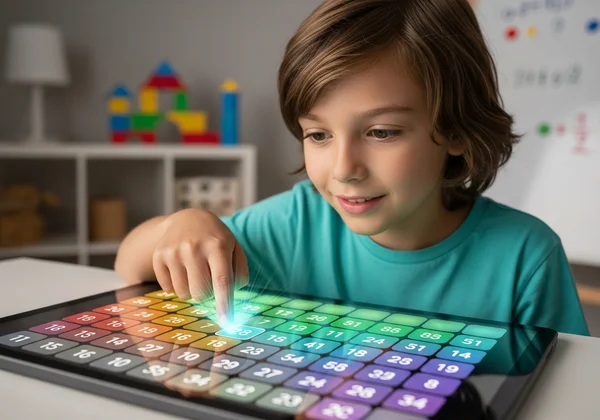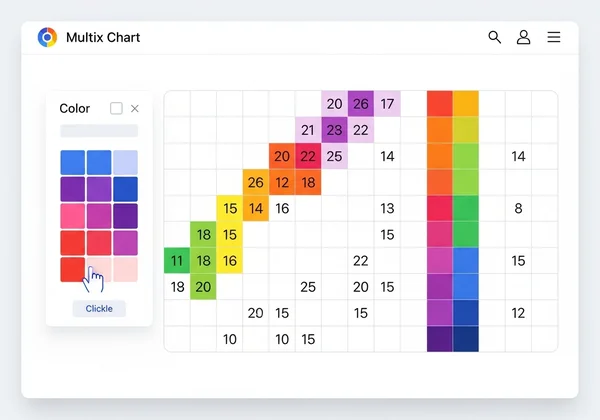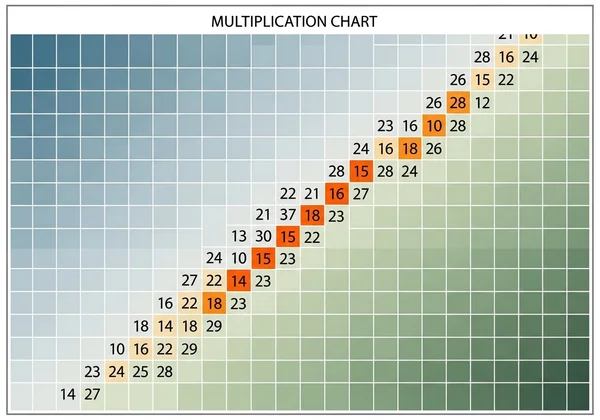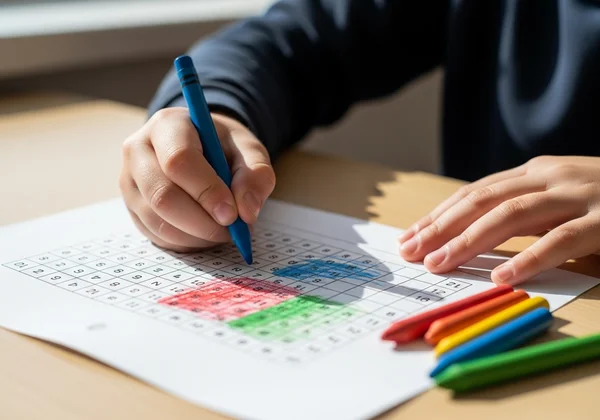Master Number Patterns with Interactive Multiplication Charts
Rote memorization can feel like a chore, turning the exciting world of numbers into a tedious task for many children. As parents and educators, we constantly search for better ways to make learning stick. How can I help my child learn multiplication in a way that is not just effective, but genuinely fun and intuitive? Instead of just memorizing, let's help kids discover the beautiful connections numbers share. Imagine transforming a standard times table chart into a colorful canvas where math rules come to life.
Visual learning truly works wonders, and it's key to our free multiplication chart. Our interactive multiplication chart is built to help students see, not just read, the logic of multiplication. The unique color-highlighting feature turns the grid into an interactive playground for discovering number patterns. Let's explore how you can unlock this powerful way of learning and help your child master multiplication with confidence and curiosity. Ready to see the patterns? [Explore our chart] now.

Unlock the Power of Interactive Multiplication Chart Patterns
A multiplication chart is more than just a grid of answers; it's a map of mathematical relationships. When students can visualize these relationships, they build a deeper, more lasting understanding. That's why interactive tools make all the difference. Instead of a static, black-and-white page, an interactive chart invites exploration and discovery.
What Are Number Patterns & Why They're Key to Mastering Multiplication
Number patterns are predictable sequences found in mathematics. In a multiplication grid, these patterns are everywhere! For example, the 5s times table always ends in a 5 or a 0. The 2s times table consists of all even numbers. Recognizing these patterns reduces cognitive load; instead of memorizing 100 individual facts, a child can learn a single rule that governs an entire row or column. This way, children develop crucial critical thinking and problem-solving skills, which are much more valuable than just memorizing. Learning multiplication becomes a treasure hunt for numerical secrets.
Getting Started: Using the Interactive Color Feature
Our interactive tool is designed for simplicity and immediate engagement. Here’s how you can start your pattern-finding adventure in seconds:
-
Visit the Homepage: Go to MultiplicationChart.cc and you'll see the interactive multiplication table right away. No sign-ups or downloads are needed.
-
Select a Color: On the left side, you'll find a palette of vibrant colors. Click on any color to select it as your "paintbrush."
-
Highlight the Numbers: Click on any cell within the multiplication grid. The cell will be filled with your chosen color.
-
Discover and Experiment: Use different colors to mark different types of numbers. For instance, use blue for all even numbers or yellow for all multiples of 3. Watch as visual patterns emerge right before your eyes!

Transform Learning with Visual Math Learning Techniques
Visual learning works incredibly well because our brains are naturally wired to understand pictures much faster than words. By color-coding a times table chart, abstract concepts become concrete and easy to grasp. This method is fantastic for visual learners and helps all students truly grasp core math principles.
Spotting Square Numbers & Symmetries with Color-Coding
Have your child pick a color and highlight the "square numbers" (1x1=1, 2x2=4, 3x3=9, etc.). They will immediately see a perfect diagonal line stretching across the chart. This simple action provides a powerful visual anchor for the concept of squares. You can also use this to explain the commutative property of multiplication (e.g., 3x7 is the same as 7x3). Ask them to find both on the chart and notice how they are symmetrically placed on either side of the diagonal line of square numbers.

Discovering Multiples and Divisibility Rules at a Glance
What do the multiples of 10 look like? Color them in and a straight, clean column of numbers ending in zero appears. This instantly demonstrates the rule for multiplying by 10. You can do the same for the 2s, 5s, or any other number. This hands-on process helps students internalize divisibility rules without forced memorization. They are not just told the rule; they discover it themselves on the [math facts table]. This ownership makes the knowledge stick.
Uncovering Secrets of Tricky Tables Like the 9s & 11s
Some tables, like the 9s, can be intimidating. But with color, the pattern becomes obvious. Highlight the multiples of 9 (9, 18, 27, 36...) and you'll see another neat diagonal line. Point out the "secret" of the 9s table: as you go down the line, the tens digit goes up by one (0, 1, 2, 3...) while the ones digit goes down by one (9, 8, 7, 6...). Suddenly, the "tricky" 9s table has a simple, predictable logic. This is one of many multiplication grid secrets waiting to be found.
Engaging in Fun Number Patterns Activities for Kids
The best learning happens when it doesn't feel like work. Our goal is to transform multiplication practice from a chore into a fun and engaging activity. By framing pattern discovery as a game, you can ignite a child's natural curiosity and make learning a joyful experience.
Interactive Exploration: A Game-Like Approach to Pattern Discovery
Turn learning into a game with these simple ideas. Challenge your child to a "pattern race"—who can find and color the multiples of 4 the fastest? Or, play "I Spy a Pattern," where one person describes a visual pattern on the colored grid and the other has to guess which times table it represents. This gamified approach leverages the tool's interactivity to keep children engaged and motivated. They'll be learning crucial math concepts while thinking they're just playing. It's a perfect example of using [online multiplication tools] for effective learning.
From Screen to Paper: Printing Your Pattern Discoveries for Offline Practice
The learning doesn't have to stop when the screen is off. After your child has created a colorful masterpiece of patterns on the interactive grid, you can use our printable multiplication chart feature. Download a blank multiplication chart and challenge them to recreate the patterns they found from memory. This reinforces their learning and bridges the gap between digital exploration and traditional paper-and-pencil practice. It's an excellent way to prepare for classroom tests while building on the fun discoveries made online. [Download your chart] for free and continue the fun offline.

Give Your Child the Gift of Visual Multiplication Mastery
Helping your child truly understand number patterns, rather than just memorize, is the best way to build lasting math confidence. Our interactive multiplication chart turns abstract numbers into a colorful world they can explore. It encourages kids to be curious learners who uncover rules for themselves. When they see the symmetry of square numbers and discover tricks for tricky tables, they build a strong, intuitive base for all their future math.
Are you ready to turn multiplication into an adventure? Visit MultiplicationChart.cc today. Let your child grab the digital paintbrush, explore the colorful world of numbers, and master multiplication in the most engaging way possible.
Frequently Asked Questions About Interactive Multiplication Charts
How can interactive charts help my child learn multiplication effectively?
Interactive charts help by making learning an active, not passive, process. Instead of just staring at a grid, children can click, highlight, and see immediate visual feedback. This hands-on approach, like the one on our site, makes abstract concepts like multiplication patterns tangible and easier to remember. It caters especially to visual and kinesthetic learners, turning practice into play.
What are the easiest ways to learn multiplication through patterns?
Start with the simplest patterns to build confidence. Using an interactive multiplication table, highlight the 10s table (all numbers end in 0), the 5s table (ends in 5 or 0), and the 2s table (all even numbers). Then, move to the 11s (e.g., 11, 22, 33) and the 9s (where the digits add up to 9, up to 9x10). Visualizing these rules on the chart makes them incredibly easy to grasp.
Can I use this interactive tool for teaching multiple math concepts?
Absolutely! While its primary focus is multiplication, the visual grid is perfect for teaching related concepts. You can use the color-coding feature to explore division (by finding how many times a number fits into another), fractions (by coloring parts of a row), and even basic number theory concepts like prime numbers. It’s a versatile and powerful [free math resource] for any classroom or home.